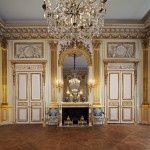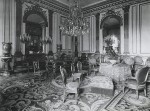 After 233 years, eight moves including one transatlantic and one transcontinental, and a meticulous 18-month conservation, the Salon Doré reopened Saturday at the Legion of Honor museum in San Francisco. The long strange journey of this gilded room began in 1781 when it was created as the formal receiving room for the Hôtel de La Trémoille, the palace of Jean-Bretagne-Godfroy, duc de la Trémoille and his wife Marie-Maximilienne, Princesse de Salm-Kirbourg, on rue Saint-Dominique in Paris’ fashionable Saint-Germain-des-Prés neighborhood where many of the old aristocracy had town homes.
After 233 years, eight moves including one transatlantic and one transcontinental, and a meticulous 18-month conservation, the Salon Doré reopened Saturday at the Legion of Honor museum in San Francisco. The long strange journey of this gilded room began in 1781 when it was created as the formal receiving room for the Hôtel de La Trémoille, the palace of Jean-Bretagne-Godfroy, duc de la Trémoille and his wife Marie-Maximilienne, Princesse de Salm-Kirbourg, on rue Saint-Dominique in Paris’ fashionable Saint-Germain-des-Prés neighborhood where many of the old aristocracy had town homes.
The paneling (boiserie in French) was neoclassical in design, with 15-foot gilded Corinthian pilasters framing four arched mirrors and four large doors. It was similar in style to the 18th century neoclassical decoration of the Hôtel de Salm, which was built on the Rue de Lille for Marie-Maximilienne’s relative Prince Frederick III, Fürst of Salm-Kyrburg, between 1782 and 1787. The Hôtel de Salm is now the Palais de la Légion d’Honneur. The Legion of Honor building in San Francisco which now houses the Salon Doré was designed to be a 2/3 scale replica of the Palais de la Légion d’Honneur.
The de la Trémoilles suffered greatly during the French Revolution. They were dedicated royalists, very close to Louis XVI and Marie Antoinette. In 1789, Jean-Bretagne-Godfroy, Marie-Maximilienne and their eldest son Charles Bretagne Marie fled France, with father and son joining the émigré army assembled by Louis Joseph de Bourbon, Prince of Condé, in Coblenz, Germany. Charles Bretagne’s wife Louise-Emmanuelle de Châtillon, whom he had wed the same year the Salon Doré was built, would not leave Marie Antoinette’s side. She was arrested after the fall of the Tuileries palace on August 10, 1792, because she refused to testify against the queen. In September she managed to make a break for it, leaving the country in disguise and joining her husband in England. Two of Jean-Bretagne-Godfroy and Marie-Maximilienne’s sons were guillotined at the peak of the Terror in 1794.
 By the mid-19th century, the Hôtel de La Trémoille belonged to the Marquise de Croix but he didn’t get to enjoy it for long. In 1877, the house was demolished during the third phase of Georges-Eugène Haussmann’s renovation of Paris. Haussmann himself was no longer in charge by then, having been fired by Emperor Napoleon III in 1870 under pressure from Republican opponents in Parliament. The emperor died in 1873 and despite the intense opposition to Haussmann’s renovations when the Napoleon III wanted them, four years later the Third Republic picked up where he left off and finished remodeling of Paris into a city of wide boulevards and elegant squares. The rue Saint-Dominique where the Hôtel de La Trémoille stood became part of today’s Boulevard Saint-Germain.
By the mid-19th century, the Hôtel de La Trémoille belonged to the Marquise de Croix but he didn’t get to enjoy it for long. In 1877, the house was demolished during the third phase of Georges-Eugène Haussmann’s renovation of Paris. Haussmann himself was no longer in charge by then, having been fired by Emperor Napoleon III in 1870 under pressure from Republican opponents in Parliament. The emperor died in 1873 and despite the intense opposition to Haussmann’s renovations when the Napoleon III wanted them, four years later the Third Republic picked up where he left off and finished remodeling of Paris into a city of wide boulevards and elegant squares. The rue Saint-Dominique where the Hôtel de La Trémoille stood became part of today’s Boulevard Saint-Germain.
The Marquise de Croix stripped the paneling off the walls before the demolition and had it installed in a first floor room in her new home, the Hôtel d’Humières on the rue de Lille. In 1905, this historic mansion also met a painfully premature demise and apartment buildings were constructed in its place. Again the Salon Doré’s boiserie was saved and in 1918, it was installed as the “French salon” in the Italianate mansion of financier Otto Kahn on East 91st Street in New York City.
The mansion was sold shortly after Kahn’s death in 1934 to the Convent of the Sacred Heart and is now schoolhouse to some very lucky middle and high school students. The Salon Doré was not part of the deal. It was stripped yet again and sold to the Duveen Brothers art dealership where it was installed a showroom in the firm’s Fifth Avenue gallery. In 1952, Duveen sold the room to steel magnate Richard Rheem who hired the French decorating firm Decour to install the salon in La Dolphine, his mansion in Burlingame, California.
 In 1959, Rheem donated the Salon Doré to the Legion of Honor in San Francisco. At the time, the museum had a policy against period rooms, but they changed it solely to accommodate the beautiful and historic Salon Doré. It was installed in 1962 and the Legion of Honor became the proud owner of one of the finest examples of French neoclassical interior design in the world. The path wasn’t smooth yet, however. In 1990 the boiserie was stripped once more as part of a major seismic retrofit of the building. When it was reinstalled, it was in a different room minus the parquet floor, ceiling, windows and two of the four doors.
In 1959, Rheem donated the Salon Doré to the Legion of Honor in San Francisco. At the time, the museum had a policy against period rooms, but they changed it solely to accommodate the beautiful and historic Salon Doré. It was installed in 1962 and the Legion of Honor became the proud owner of one of the finest examples of French neoclassical interior design in the world. The path wasn’t smooth yet, however. In 1990 the boiserie was stripped once more as part of a major seismic retrofit of the building. When it was reinstalled, it was in a different room minus the parquet floor, ceiling, windows and two of the four doors.
All the moves and reinstallations had left the room far from its original configuration. The museum didn’t even know the proper history of the salon because the Duveens had lied about its provenance to connect it to a more famous palace and architect and presumably charge a higher price for it. Martin Chapman, the museum’s curator of European decorative arts and sculpture, recognized the importance of the room and decided to thoroughly research it so it could be restored to a more period accurate condition.
In 2013, the room was closed for a full refurbishment. The paneling was removed for restoration of its carved elements and gilding. Watch it come down in this time lapse video:
[youtube=http://youtu.be/vkrB_XIm4cA&w=430]
“The aim of this project has been to reinstate this paneling as an architectural entity as well as recreating its program for furnishing based on the 1790 inventory of the room. It was also to provide a full picture of how these salons functioned in the years before the Revolution swept away the culture of the ancien régime and to understand the essential relationship between the furniture and the interior architecture,” said Martin Chapman.
In order to achieve this extensive restoration project, a laboratory was set up in an adjacent gallery that could be viewed by visitors to the museum. In this space, up to 16 specialists worked on the carving and gilding under the direction of Fine Arts Museums’ head objects conservator, Lesley Bone, and the Museums’ conservator of frames and gilded surfaces, Natasa Morovic. The furniture’s upholstery was researched and executed by Xavier Bonnet of Atelier Saint-Louis, Paris. The silk incorporated in the room was woven by Tassinari and Chatel in Lyon, France to a design matched to an 18th century document in that city’s Musée de Tissus et des Arts décoratifs. The trimming by Declercq was laboriously made using traditional techniques and designs derived from 18th century models.
You can see the gilding restoration in this video:
[youtube=http://youtu.be/z1VKWweoKvM&w=430]
And the master carver doing his magic in this one:
[youtube=http://youtu.be/gz8CzoGaHY4&w=430]
Cutting edge technology worked side-by-side with traditional crafts. Conservators used 3D printer to recreate the missing cradle of an 18th French century clock for the Salon Doré.
[youtube=http://youtu.be/CFUIpZOorns&w=430]
The restored panels were installed according to the original floor plan in a new room with period appropriate parquet flooring donated by French antiques dealer Benjamin Steinitz, a coved ceiling, windows and new lighting. Some of the furniture and accessories (a chandelier, three Sèvres vase) came from the Legion of Honor’s collection. Other pieces — a large mirror, a console, chairs — were purchased from various antiques dealers in Paris.
The end result is nothing short of exquisite.
“The Salon Doré will be the only pre-Revolutionary Parisian salon in the United States displayed with its full complement of furnishings. Returning the room to its original glory and revealing its initial purpose, the Fine Arts Museums of San Francisco present the Salon Doré as an example of how a period room can engage a 21st century audience,” said Colin B. Bailey, director of the Fine Arts Museums of San Francisco.
Damn, I was visiting the Legion of Honour Museum in San Francisco last August, but that was too early. Nothing was ready yet. Returning the room to its original glory and revealing its initial purpose is indeed the ultimate goal, so I will simply have to go back again later this year. No choice, really.